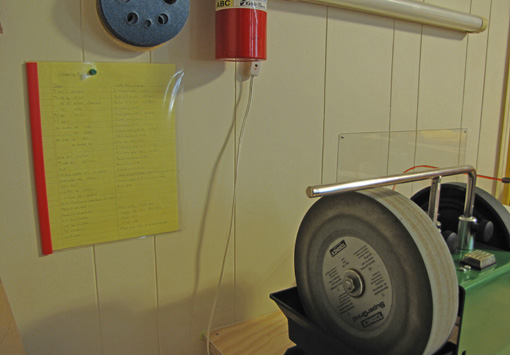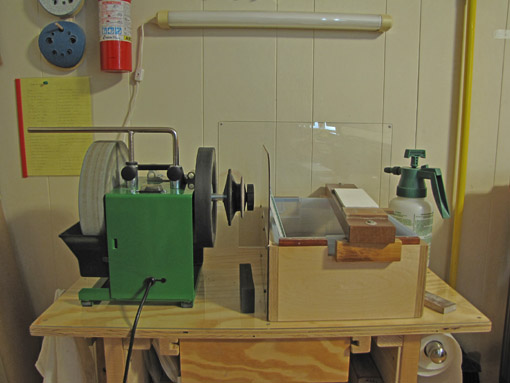
The yellow sheet, thumb-tacked to the wall near my sharpening bench, saves a lot of time and guesswork. On it, I’ve listed the primary and secondary sharpening bevels for each of my edge tools.
Writing or scratching this information directly on each tool is awkward and often hard to read. It’s much easier to keep this sharpening “recipe” list. It is written in pencil because I sometimes change the angles as I get to know the performance of the steel in a new tool, or if I prepare a tool for working different woods. It pays to observe the edge wear and feel of an unfamiliar tool, taking note of any chipping and the resistance of the tool in the cut, and account for these in the next sharpening. Thus, the recipe develops from knowledge of the type of steel and feedback from the performance of the specific tool.
I grind the primary bevel on the Tormek, setting the angle from the recipe using Tormek’s proprietary gauge. I prefer to grind to just short of the tool’s edge which avoids unnecessary clean up on the coarse/medium waterstones. With the exception of most knives and some carving tools, I do not like the Tormek’s leather wheel for honing.
The Kell bevel gauge is handy to check tools, particularly since the Tormek gauge can sometimes induce inaccuracy if a lot of steel is removed during grinding. Most of the time, though, I just work directly from the recipe and try to get back to woodworking as soon as I can.



Hi Rob,
What brand of water stones do you used?
Chris
Hi Rob,
I have found the Wixey Digital Angle Gauge (http://www.wixey.com/anglegauge/index.html) to be an incredible benefit.
There has been much discussion on tool forums about the Tormek and problems associated with getting reliable and repeatable 90 degree edges off the jig. I own their first model and have been quite frustrated with this problem. It took me a lot of steel to realize that the clamping faces on the square edge jig had to be kept dead parallel when tightening. It still doesn’t solve the problem, though. What is your experience?
One other question: what determines the distance between the bar above the stone and the stone surface? David Charlesworth says he always uses 3/8″. Is this somewhat arbitrary?
Best,
Tico
Chris,
I use Shapton glass stones. They’re good but I don’t know if I’d recommend them as the top choice simply because there are so many stones that I haven’t tried but have heard good things about. Naniwa and Sigma Power brands seem to be getting a lot of attention lately.
Tico,
Yea, I have the iGaging brand and I’m learning that it comes in handy more and more often.
Squaring the grind on the Tormek can be dicey. I set it up as best I can then grind for a few seconds, look at the grind marks to see how I’m doing, and adjust from there. It would be nice to just dial it in though. I color the bevel with a black marker pen if I need to be more exact.
For short-blade tools such as Japanese chisels, the height of the bar is usually dictated by how the tool can be secured in the jig. When there is more range, such as for a plane blade, I keep the bar fairly low. The important thing is that I just estimate how much the blade projects from the jig, the I use the microadjuster nut for the bar height to dial in the exact angle of the blade to the stone.
Rob
Your idea has been stolen! I have been checking manuals, and internet sites to find out how to sharpen tools… This is a no-brainer that apparently I was not able to come up with. I told a friend about it, and he said that he has a white board in his shop for random notes.
John,
Oh, I’m sure this is not an original idea. It’s just something that works for me and I wanted to share.
Rob